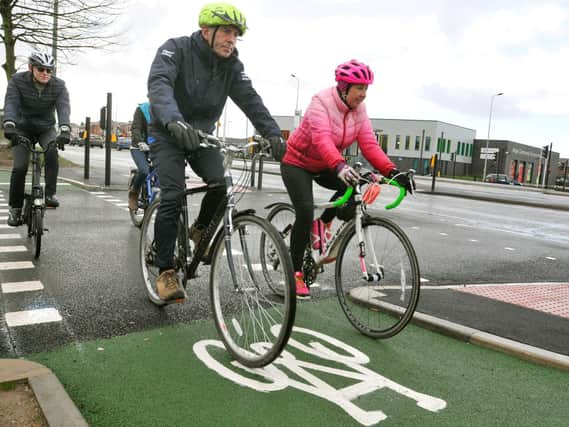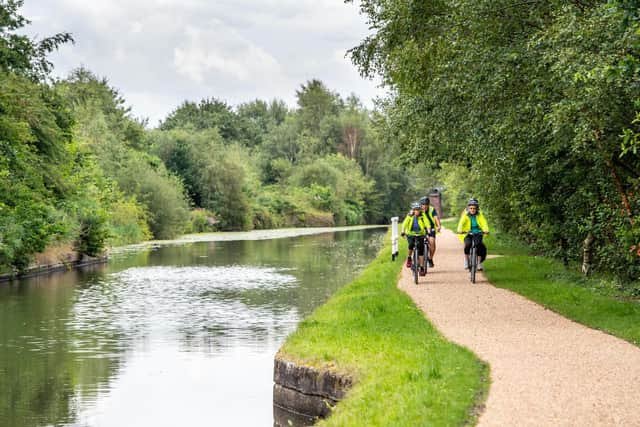More still to do to get Wigan residents travelling by bike or on foot, data shows


The statistic was revealed by BBC Shared Data Unit analysis of the most recent National Travel Survey and Active Lives Survey.
As lockdown eases, those who cannot work from home are being encouraged to avoid public transport as they go back to their jobs.
Advertisement
Hide AdAdvertisement
Hide AdThis leaves pedal or foot power as the preferred option for commuting for residents unable to travel by car.


Cycling organisations say that one of the biggest hurdles to getting people riding more is safety, and local authorities across the country are ploughing millions into making commutes easier and less hazardous for those on two wheels.
Wigan has also seen a number of major infrastructure projects for public transport, including the creation of more cycle lanes, in recent times.
And changes have been made to the borough’s road network during the coronavirus crisis to make social distancing easier for pedestrians and riders.
Advertisement
Hide AdAdvertisement
Hide AdHowever, Wigan Council did acknowledge that the survey suggested there is still more that can be done.
Mark Tilley, assistant director of infrastructure at Wigan Council, said: “We recognise the efforts that can continue to be made to encourage more residents to take up healthier lifestyles.
“That is why the council has embarked on a mission to improve our cycling and walking networks to make it easier and safer for pedestrians and cyclists to move around the borough.
“Working with our Greater Manchester counterparts, a number of projects have been completed.
Advertisement
Hide AdAdvertisement
Hide Ad“Just last year, the debut project in the Bee Network, the largest-ever investment in the city region’s walking and cycling network, was opened down the Bridgewater Canal towpath in Astley.
“Plans are also in place to make cycle-friendly improvements to the Victoria Street junction to sit along the already-constructed Saddle Junction and Robin Park Road cycle schemes.
“Earlier this month the leader of Wigan Council also approved new measures such as temporarily extending the pedestrian zone times in Wigan and Leigh town centres and introducing 20mph speed limits on some Wigan town centre roads so pedestrians and cyclists can feel more confident about moving safely and freely while adhering to social distancing measures.
“Many aspects of the way we live our lives may change once we come out of this pandemic and the council will continue to explore sustainable transport alternatives for residents to utilise in the future.”
Advertisement
Hide AdAdvertisement
Hide AdGreater Manchester has seen an increase in attention and spending on sustainable transport, with Olympian Chris Boardman working as cycling and walking commissioner for the region.
The survey showed 13.5 per cent of Wiganers cycle at least once a month, with 11.7 per cent doing so for leisure and 4.7 per cent for the purposes of getting from A to B.
Around 72.8 per cent of borough residents walk at least once a month, with 64.8 per cent striding out on a weekly basis.
Safety remains one of the biggest barriers to getting larger numbers in the saddle, with Cycling UK saying more investment in dedicated infrastructure such as separate bike lanes is crucial in changing perceptions.
Advertisement
Hide AdAdvertisement
Hide AdThe organisation published a survey which found 11 per cent of North West adults had cycled more since the lockdown.
When asked what would encourage them to ride more once lockdown is lifted 53 per cent said direct routes to town centres and high streets where the road space was not shared with cars and 45 per cent said more designated cycle lanes.
Sam Jones from Cycling UK said: “This is a golden oppportunity to get more people riding but that does require giving people the infrastructure to make them feel safe, and for their kids to feel safe as well.
“Cycling is actually no more dangerous than walking per mile travelled, but we know the greatets barrier to most people when they take up cycling is a perception of danger.”